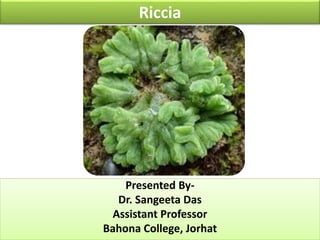Riccia
•
2 likes•1,712 views
This ppt describes about the genus Riccia, its distribution, habiata, gametophytis as well as sporophytic phase, etc. Hope it will help the students of Botany in preparing for their examk nations.
Report
Share
Report
Share

Recommended
More Related Content
What's hot
What's hot (20)
Chara algae Morphology Cell Structure Reproduction

Chara algae Morphology Cell Structure Reproduction
Similar to Riccia
Similar to Riccia (20)
ANTHOCEROS(bryophyta) Faizan botany department GPGC kohat

ANTHOCEROS(bryophyta) Faizan botany department GPGC kohat
Phylum lycophyta (Club mosses, Spike mosses & Quillworts)

Phylum lycophyta (Club mosses, Spike mosses & Quillworts)
More from Sangeeta Das
More from Sangeeta Das (20)
Recently uploaded
Recently uploaded (20)
insect taxonomy importance systematics and classification

insect taxonomy importance systematics and classification
GBSN - Microbiology (Lab 1) Microbiology Lab Safety Procedures

GBSN - Microbiology (Lab 1) Microbiology Lab Safety Procedures
The ASGCT Annual Meeting was packed with exciting progress in the field advan...

The ASGCT Annual Meeting was packed with exciting progress in the field advan...
Constraints on Neutrino Natal Kicks from Black-Hole Binary VFTS 243

Constraints on Neutrino Natal Kicks from Black-Hole Binary VFTS 243
Detectability of Solar Panels as a Technosignature

Detectability of Solar Panels as a Technosignature
word2vec, node2vec, graph2vec, X2vec: Towards a Theory of Vector Embeddings o...

word2vec, node2vec, graph2vec, X2vec: Towards a Theory of Vector Embeddings o...
Multi-source connectivity as the driver of solar wind variability in the heli...

Multi-source connectivity as the driver of solar wind variability in the heli...
Astronomy Update- Curiosity’s exploration of Mars _ Local Briefs _ leadertele...

Astronomy Update- Curiosity’s exploration of Mars _ Local Briefs _ leadertele...
Extensive Pollution of Uranus and Neptune’s Atmospheres by Upsweep of Icy Mat...

Extensive Pollution of Uranus and Neptune’s Atmospheres by Upsweep of Icy Mat...
Mammalian Pineal Body Structure and Also Functions

Mammalian Pineal Body Structure and Also Functions
Cancer cell metabolism: special Reference to Lactate Pathway

Cancer cell metabolism: special Reference to Lactate Pathway
THE IMPORTANCE OF MARTIAN ATMOSPHERE SAMPLE RETURN.

THE IMPORTANCE OF MARTIAN ATMOSPHERE SAMPLE RETURN.
Riccia
- 1. Riccia Presented By- Dr. Sangeeta Das Assistant Professor Bahona College, Jorhat
- 2. Systematic Position of Riccia: Division- Bryophyta Class- Hepaticopsida Order- Marchantiales Family- Ricciaceae Genus- Riccia
- 3. Distribution and Habitat of Riccia: Riccia, is a cosmopolitan genus. Widely distributed in both tropical and temperate regions of the world. It is represented by about 138 species. All species are terrestrial and prefer to grow on damp soil or rocks except Riccia fluitans, which is an aquatic species and occurs floating in ponds and lakes.
- 4. GAMETOPHYTIC PHASE A. External Morphology: Thalloid fleshy, prostrate. They are dichotomously branched, dorsoventrally flattened and wedge-shaped (obcordate). Repeated dichotomy results into a typically rosette like appearance (Figs. 1, 3). In Riccia cruciata only two dichotomy result in a cruciate form.
- 5. Anatomy The thallus of Riccia is internally differentiated into: 1. Upper Assimilatory Region: 2. Lower storage region.
- 6. 1. Upper Assimilatory Region: The chloroplast-rich assimilatory cells are stacked over one another, forming a filament which serves as a column of air chamber. The uppermost cells of assimilatory filaments lack chloroplasts and together form a loose epidermis. Each air chamber opens on the dorsal surface by an air pore which help in the gaseous exchange.
- 7. 2. Lower storage region The lower storage region is made up of thin-walled, non-chlorophyllous cells. These cells contain starch as reserve food material.
- 8. Reproduction in Riccia: Riccia reproduces by vegetative and sexual methods.
- 9. A. Vegetative Reproduction: 1. By death and decay of the older portion of the thallus. 2. By adventitious branches: The adventitious branches develop from the ventral surface of the thallus e.g., Riccia fluitans. On being separated, these branches develop into new thalli. 3. By persistent apices: Due to prolonged dry summer or towards the end of growing season the whole thallus in some species (e.g., Riccia discolor) dries and gets destroyed except the growing point. Under favourable environmental conditions it develops into a new thallus.
- 10. A. Vegetative Reproduction: 4. By tubers. 5. By rhizoids:The apical part of the young rhizoids divides and re-divides to form a gemma like mass of chloroplast containing cells in some species (e.g., Riccia glauca). These cells are capable of developing into new thallus.
- 11. B. Sexual Reproduction: Sexual reproduction in Riccia is of oogamous type. The species of Riccia may be homothallic (monoecious) e.g., H. billaridieri, R. crystallina, R. glauca or heterothallic (dioecious) e.g., R. discolor, R. perssonii, R. frostii. The sex organs are born in the region of median furrow and are embedded in the thallus. The male sex organ is known as the antheridium and the female, the archegonium.
- 12. SPOROPHYTIC PHASE After fertilization the diploid zygote or oospore is formed. It then enlarges until it completely fills the cavity of the venter of the archegonium. It secretes a cell wall around the oospore. The wall of the venter also undergoes division. It divides anticlinally and periclinally to form a two- layered calyptra along the developing sporophyte.
- 13. Fig. Riccia. T.S. of thallus passing through the sporogonium.
- 14. Life cycle of Riccia
